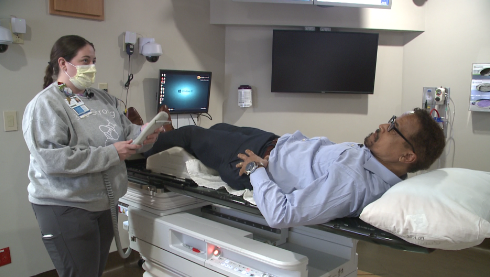NORFOLK, Va. — Moving forward! I have an update now on my prostate cancer diagnosis. After months of weighing my options, I've finally made a choice on this journey to rid cancer from my body.
It was about three months ago I heard these words from Dr. John Liu from Urology of Virginia, following my biopsy, "Well Kurt, unfortunately, we did find, you know— a few areas of prostate cancer."

Health
Kurt Williams gives glimpse behind the curtain with prostate cancer diagnosis
I will soon start radiation treatments at Sentara Norfolk General Hospital under the care of Dr. Mark Shaves, a radiation oncologist.
I asked him if will I feel different after the radiation.
"No, you're going to feel exactly the same coming into this clinic each day and leaving," Dr. Shaves said. "You can do whatever you want. If you want to shoot golf, if you want to go to the gym, there's really no limit to what you can do during your radiation therapy."

News
Kurt Williams takes next step in prostate cancer journey
But Dr. Shaves points out there likely will be side effects.
"Typically people are going to have frequent urination, a little bit more urge to go, maybe getting up more at night, slower stream, generally those are mild and they go away within a few weeks," he said.
Danielle Mowery, a radiation therapist at Sentara Norfolk General, says an important part of each daily treatment: drinking a lot of water.
"This is the image receptor and it kind of takes a mini-CT-scan...so that's how we know if your bladder is full for your treatment," Mowery explained.

I asked her why it was necessary to have a full bladder.
"It expands everything; so it kind of pushes your rectum out of the way and pushes your prostate in where it needs to be, so we don't treat any unnecessary tissue," she said.

This treatment only lasts about five minutes, but I will come here for five weeks, Monday through Friday. After those 25 treatments wrap up, then I'll skip a month, and then I'll start the next phase: the seed implants.
Dr. Shaves showed me the tiny seeds.
"They're super small," he said. "It looks like you almost took a mechanical pencil lead and broke it off in pieces."
The seeds are loaded in needles, then using computers and an ultrasound probe, they are surgically implanted into the prostate. Between 60 to 125 seeds could be implanted.
Watch more of Kurt's journey: Kurt Williams gives glimpse behind the curtain with prostate cancer diagnosis
"And the seeds will stay in forever and over the next several months they will gradually lose their radiation therapy and as they do that, they'll treat your prostate and the cancer that's there," said Dr. Shaves.
Hormone therapy—taking a daily pill— is also a part of my treatment.
"Prostate cancer, they found out some decades ago, thrives on the male hormone testosterone and when we deprive it of that hormone it essentially dies," Dr. Shaves explained.

Health
Kurt Williams's next step on cancer journey: Is it confined to the prostate?
But if that's the case, why do I even need the radiation?
"While the hormone therapy is powerful in its attack against the prostate cancer, it won't cure you all by itself," said Dr. Shaves. "There are different populations of cells within everyone's prostate cancer. Some of those cells are more sensitive to the hormone therapy and some are less sensitive to the hormone therapy. And the ones that are less sensitive, they keep on thriving, so we need another treatment to kill, especially those cells off."
Dr. Shaves shared that there are potential side effects of the hormone therapy: "Fatigue and it varies with people, some people feel very little and some feel that stronger. You can get hot flashes; you will just from time to time feel hot and then it will go away."

Health
Don't fear the finger: Get your prostate checked
He also pointed out one of the advantages of the combo radiation approach with the radioactive seeds.
"In patients that are just getting beam therapy alone without the seed implant, we recommend between 18 and 24 months of hormone therapy," he said. But if you go with combo approach, Dr. Shaves said, "It varies but typically six and nine months. So there's quite a bit less time on hormone therapy required when you have a seed implant which is one of the benefits of that combination therapy."
My radiation treatments should start the mid to latter part of April. I've already been on the hormone therapy for a few weeks and so far the side effects have been pretty mild.









